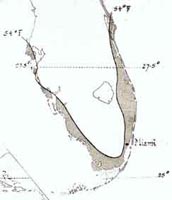About Subtropical Florida Lichen Study
A small part of South Florida has a unique flora and climate, when compared to the rest of the United States and Canada. Globally, it is more closely related to tropical areas of the world. But since it is wholly situated north of the Tropic of Cancer, we use the term Subtropical Florida when referring to it. It is defined as the part of Florida with an average January temperature  greater than 54°F. This appears as the dark coastal area in the graphic to the left. In the interior it extends from the southern tip of Florida to just north of Tamiami Trail.
greater than 54°F. This appears as the dark coastal area in the graphic to the left. In the interior it extends from the southern tip of Florida to just north of Tamiami Trail.
The lichen flora is different here with graphid and pyrenolichens abounding, the former not being common on the rest of the continent (north of Mexico).
In contrast, foliose lichens are less common with Parmotrema, Physcia, Dirinaria and the jelly lichens (Leptogium) representing a large portion of this growth form.
The marvelous self published works of Richard C. Harris (Some Florida Lichens 1990 and More Florida Lichens 1995), although covering northern Florida more extensively than southern, still represent the majority of published material applicable to Subtropical Florida. However, this situation is changing rapidly with the help of Robert Lücking of the Chicago Field Museum with his monumental works on many tropical genera and Fakahatchee Strand State Preserve lichens. In 2011 the results of the 2009 Tuckerman Workshop (a worldwide gathering of lichenologists, ourselves included, held at Fakahatchee Strand) were published.
This first ever major lichen publication for our region can be acquired at http://www.flmnh.ufl.edu/bulletin/bulletin_vols.htm. (Scroll to vol. 49 and download the text and photos of 432 species discovered at Fakahatchee Strand.) 18 of these species were never before identified by scientists and nearly 100 were previously not known to exist in North America. This appears to be more lichen biodiversity in a relatively small space than anywhere else in North America according to Lücking.
These findings are not a surprise to us since we have been operating a volunteer lichen laboratory at Everglades National Park for the last 3 years. Hopefully our findings will be helpful in assessing the success of Everglades restoration efforts. Collaboration with professional lichenologists, such as Drs. Harris and Lücking who is experienced in tropical lichens, has been a huge boost to our efforts. R. Seavey says “Fakahatchee (workshop) was an eye-opener to me. It dawned on me that all the species I couldn’t put a name to hadn’t been described.” Lücking’s extensive collaborative publications describing new tropical species make possible our ability to document South Florida’s unique place in the lichen world.
But much more needs to be done if the lichen flora of this region is to be understood.
Within Subtropical Florida most native trees and plant communities of both coasts have been lost to development. However, the extreme southern portion of the region has been preserved through the establishment of Big Cypress National Preserve (570,000 acres), Everglades National Park (1,509,000 acres) and Biscayne National Park. The problem of surveying lichens in this vast expanse is one of accessibility. Unique plant communities, each with at least a slightly (or greatly) different lichen mix, are not easily reached by trails or roads which are very few in number. Common impediments include high water levels (necessitating wading in sometimes waist deep water), alligators (not as much threat as everyone perceives), poisonous snakes (most dangerous are the diamondback rattlesnake and the cottonmouth water moccasin) and an extremely high mosquito population at certain times of the year). In addition, the 1000's of outer islands and unique beach flora of the Cape Sable region offer their own lichen assemblages but are accessible only by boat.